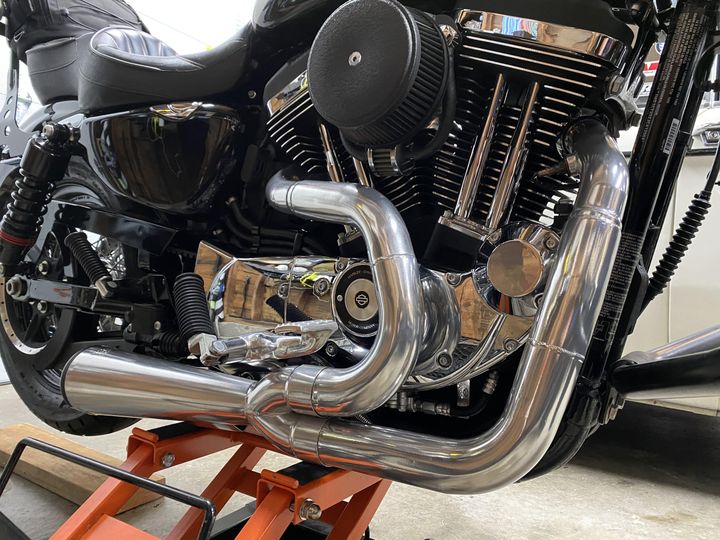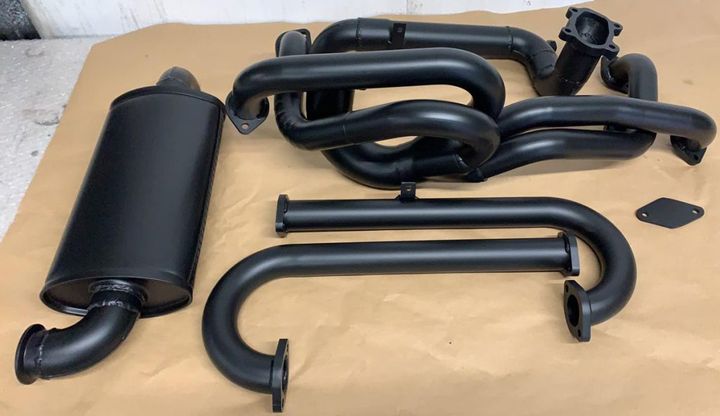


Motorcycle enthusiasts often look for ways to customize and enhance the appearance of their bikes, including the exhaust system. Powder coating is a popular finishing technique that involves applying a dry powder coating material through an electrostatic process and then curing it with heat to create a durable, protective layer. The question of whether motorcycle exhaust components can be powder coated has been a topic of discussion among riders and customizers.

One of the primary concerns when it comes to powder coating motorcycle exhausts is the extreme temperatures these components endure during operation. Motorcycle exhausts can reach scorching temperatures, as shown in the table below:
| Exhaust Component | Temperature Range |
|---|---|
| Header Pipes | Up to 1200°F (650°C) |
| Mid-Pipes | Up to 1200°F (650°C) |
| Catalytic Converters | Up to 1200°F (650°C) |
| Mufflers | 800°F - 1000°F (425°C - 540°C) |
Conventional powder coatings are typically rated to withstand temperatures only up to 400-450°F, which is insufficient for the hottest parts of the exhaust system. When exposed to these high temperatures, regular powder coatings will inevitably degrade, leading to various issues:
Discoloration
Flaking
Bubbling
Burning or charring of the coating
This degradation not only compromises the aesthetic appeal but can also lead to potential performance-related problems, such as exhaust leaks or backfiring.
If you've already powder coated your motorcycle's exhaust and are experiencing issues, there are several telltale signs to look out for:
Discoloration of the powder coated surface
Flaking or peeling of the coating
Bubbling or blistering of the coating
Burnt or charred areas on the coating
Loud popping or backfiring noises, which could indicate an exhaust leak due to coating failure.
To confirm the presence of a leak, you can perform a simple leak test by following these steps:
Start the engine and let it idle.
Prepare a solution of soapy water in a spray bottle.
Spray the soapy water around the exhaust flanges and joints.
Look for growing bubbles, which indicate a leak in the exhaust system, likely caused by the degradation of the powder coating.
If you're facing minor issues with your powder coated exhaust, you may be able to apply additional layers of high-temperature powder coating or matching high-temp paint over the affected areas. This can be a temporary solution, but it's important to note that the underlying issue of heat degradation will likely persist.
For larger areas of damage or widespread coating failure, you'll likely need to completely strip off the old coating and re-apply a new high-temperature powder coat designed specifically for exhaust systems. Here are the steps involved:
Surface Preparation:
Sandblasting or media blasting to remove the old coating and any contaminants
Thorough cleaning and degreasing of the exhaust components
Degassing to remove any residual oils or moisture
Coating Application:
Apply a high-temperature powder coating specifically designed for exhaust systems, which can withstand temperatures up to 650°C (1200°F)
Follow the manufacturer's instructions for proper application and curing
To prevent recurrence of the issue, it's essential to take the following precautions:
Use high-temperature powder coatings explicitly designed for exhaust systems, which can withstand temperatures up to 650°C (1200°F).
Consider more durable coating options like ceramic coatings or chrome plating for the hottest exhaust components.
Regularly inspect and maintain the exhaust system to catch any issues early.
Here's a comparison of different coating options for motorcycle exhausts:
| Coating Option | Temperature Resistance | Durability | Cost |
|---|---|---|---|
| Regular Powder Coating | Up to 400-450°F | Low | $ |
| High-Temp Powder Coating | Up to 650°C (1200°F) | Moderate | $$ |
| Ceramic Coating | Up to 1200°C (2192°F) | High | $$$ |
| Chrome Plating | Up to 900°C (1652°F) | High | $$$ |
While high-temperature powder coatings and ceramic coatings may be more expensive upfront, they can provide a longer-lasting solution and potentially save you money in the long run by reducing the need for frequent reapplication.
The cost of powder coating a motorcycle exhaust can vary depending on the shop, the specific components involved, and the type of coating used. Based on my experience and research, here are some approximate cost estimates:

Exhaust headers: $220 - $270 + GST
Complete exhaust system: $220 - $270 + GST
High-temperature powder coating for exhaust: $250 + GST
Ceramic coating: $400 - $600 + GST
Chrome plating: $300 - $500 + GST
It's important to note that regular powder coating may need to be redone every 3 months due to heat degradation, increasing the overall cost over time. High-temperature powder coats, ceramic coatings, or chrome plating, while more expensive upfront, can provide a longer-lasting solution for motorcycle exhausts, potentially saving you money in the long run.
While the idea of powder coating your motorcycle's exhaust may seem appealing from an aesthetic standpoint, it's crucial to understand the limitations and challenges involved. Regular powder coatings are simply not designed to withstand the extreme temperatures encountered by exhaust systems, leading to premature degradation and potential performance issues.
If you're determined to customize the appearance of your exhaust, it's essential to invest in high-temperature powder coatings, ceramic coatings, or alternative coatings specifically designed for exhaust systems. Additionally, regular maintenance and inspection are key to ensuring the longevity and proper functioning of your exhaust system.
As a mechanic, my primary concern is ensuring the safety and performance of your motorcycle. While aesthetics are important, they should never compromise the integrity of critical components like the exhaust system. By understanding the limitations and taking the necessary precautions, you can enjoy the best of both worlds – a visually appealing exhaust system that performs reliably and safely.
Yes, you can powder coat stainless steel exhaust pipes, but it requires proper surface preparation and the use of high-temperature powder coatings designed for exhaust systems.
The lifespan of a powder coated exhaust depends on the type of coating used, but regular powder coatings may only last 3-6 months before degrading due to high heat exposure.
Powder coating exhaust pipes can enhance the appearance, but it may not be worth it if using regular powder coatings due to their short lifespan and potential for degradation.
Yes, you can powder coat over chrome exhaust pipes, but the chrome surface must be properly prepared and a high-temperature powder coating designed for exhausts must be used.
The cost of ceramic coating exhaust pipes can range from $400 to $600 or more, depending on the shop and the specific components involved.
Powder coating can be removed from exhaust pipes through sandblasting, media blasting, or chemical stripping methods, followed by thorough cleaning and degreasing.
Yes, titanium exhaust pipes can be powder coated, but they require specialized surface preparation and high-temperature powder coatings designed for exhaust systems.
Exhaust pipes must be thoroughly cleaned, degreased, and degassed before powder coating. Sandblasting or media blasting may also be required to remove any existing coatings or contaminants.
The best powder coating for motorcycle exhaust is a high-temperature powder coating specifically designed for exhaust systems, which can withstand temperatures up to 650°C (1200°F).
Yes, carbon fiber exhaust tips can be powder coated, but they require proper surface preparation and the use of high-temperature powder coatings designed for exhaust systems.

Sarah isn't your average gearhead. With a double major in Mechanical Engineering and Automotive Technology, she dived straight into the world of car repair. After 15 years of turning wrenches at dealerships and independent shops, Sarah joined MICDOT to share her expertise and passion for making cars run like new. Her in-depth knowledge and knack for explaining complex issues in simple terms make her a valuable asset to our team.











